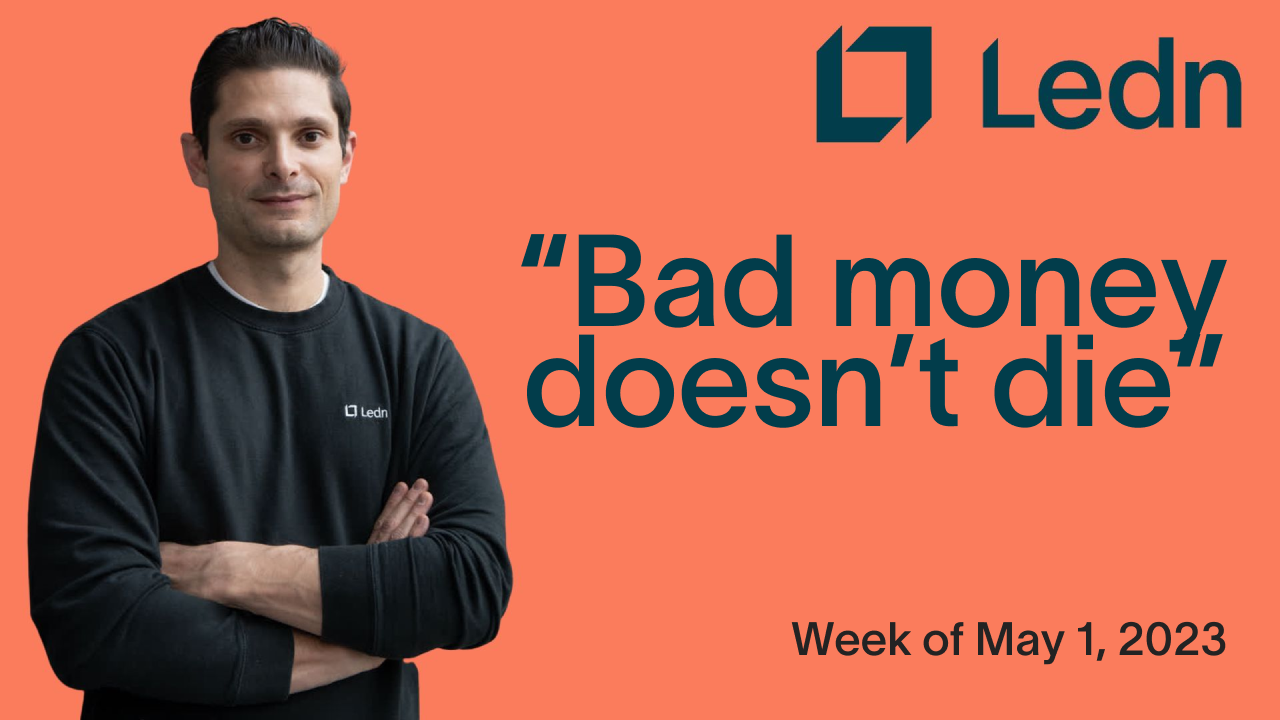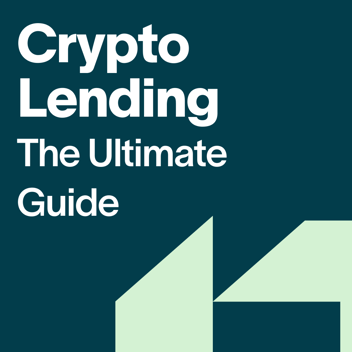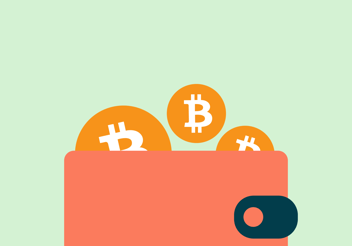Bad money doesn't die

Bitcoin
Bitcoin price action has continued to consolidate around $28k in nearly text-book fashion after its March 13th move higher. As you may remember from our April 3rd issue, we highlighted that, historically, Bitcoin price tends to stabilize for several weeks after ~20% moves with strong volume:
April 3rd chart:

May 3rd chart:

In previous instances, like November 2021 and May 2022, bitcoin broke out of its tight range after 7-8 weeks of sideways price action. Currently, bitcoin is in its 7th week of range-bound trading, and this week is loaded with data - which could be the straw that forces bitcoin prices to break out of the $27-$29k range.
The bitcoin futures curve is starting to show some flattening and even backwardation in the case of one venue. This, combined with the fact that the funding rate for bitcoin perpetual futures across major platforms is roughly 0%, and that short interest in major exchanges remains at near historical lows, suggests that investors are not going into the Fed decision day with expectations of a large move in either direction.

Having said that, there is still a significant amount of open interest in bitcoin futures. This suggests that there is leverage in the system, most likely with a “long” bias, that could trigger a move down in the event of a surprise negative announcement.

A dip in price would be welcomed by a multitude of investors that have been waiting for a dip since Bitcoin’s move higher on March 13th.
In terms of key support and resistance levels, we continue to monitor the 200-week moving average price, currently at $26,025 as key support in the event of a move lower. In terms of upper-bound resistance levels, we continue to track the $30k and $35k levels.
Digital Asset Markets:
Bad money doesn’t die.
If there is a currency that should have died a long time ago, it is the Venezuelan Bolivar.

In 15 years, it has lost so much value that the central bank had to intervene three separate times to rename the currency and change the denomination of the bills. In the process, it removed fourteen (14) zeroes from the bills. That is the number of zeros in 100 Trillion (100,000,000,000,000).
To put this into context, Bloomberg publishes its “Cafe con Leche” indicator, which states that as of last week, the average price of a latte coffee in Venezuela was 61.52 bolívares. This means that, if you were using the same bills from 15 years ago, you’d be paying 615,200,000,000,000 Bolívares for a coffee. If you have issues reading that number out loud, I don’t blame you. That’s six hundred and fifteen point two trillion “original bolívares” for a coffee.

Needless to say, the currency is absolutely useless as a “store of value”.
The rapid inflation also renders it useless as a “unit of account”. The bolivar is so useless as a unit of account, that even the Venezuelan regime announced its most recent salary adjustment in U.S. dollar terms, and not in the “national currency”.

For further context, the chart below shows that at peak hyperinflation, it took just 3 months for the bolivar to lose 90% of its value.

Lastly, there are two use-cases left for the bolivar as “medium of exchange”: as spare change when you don’t have exact amounts to pay with U.S. dollars, and of course, for government-related payments. The government forces you to pay Venezuelan taxes in bolívares, and issues subsidies and salary payments to government workers in bolívares.
So, to recap: the bolívar is no bueno as a store of value, useless as a unit of account, and has 2 narrow use-cases as a medium of exchange.
However, herein lies the key of why bad money doesn’t die: politics.
One way to look at it is the following: countries can’t go bankrupt.
If a country with the ability to print its own currency does not generate enough revenue to meet its expenses, it prints the difference. By doing so, it directly hurts all of its citizens that are saving in that currency. And - over a long enough time frame of this behaviour, the hope is that the citizenry becomes crippled by the pain, and votes the irresponsible government out democratically.
However, this model breaks under certain scenarios. One such scenario is when democracies derange into dictatorships. This has happened in Venezuela, Zimbabwe, Cuba, Iran and many other countries. Do you see a pattern here between dictatorships and broken money?
Many of the countries mentioned above, are - by many accounts, failed states. For context, in Cuba, they just announced that chicken won’t be coming in its monthly subsidy “meal box” to anyone over the age of 14, until further notice.

No democracy means no opportunity for change. This is why thousands of people risk their lives every day to sail from Cuba to the United States, or to cross the Darien Jungle escaping Venezuela on foot to try to make it to the U.S.


There is a very good reason why millions of Cubans, Venezuelans, Zimbabweans, Iranians, and many more use a currency that they know is broken: they don’t have a choice.
And the sad reality is that democracy looks to be a long way away for these people. So much so, that they would rather risk their lives trying to leave, than continue to live in a system that has caused them so much pain - and yet, they feel like they can’t change.
Tyrannical governments have no democratic pressure. They will never give up their right to print the national currency. Doing so means giving up their financing. And giving up their financing means facing justice.
Through better money, like bitcoin, we can greatly diminish the political power of the national currency. Not using their currency effectively makes every unit of money they print directly fuel inflation. It forces the regime to operate in a constant state of hyperinflation - as we are witnessing in Venezuela today. Using better money diminishes the power of the ruling dictator. The hope is that, over time, this pressure allows for a change in government. However, we have not seen this in Cuba, North Korea, Zimbabwe, or many of the other countries that we’ve referenced in the last few decades.
Now that we’ve covered why the worst of the worst of currencies have not died since, let’s take a look at why even some of the good ones are nearly impossible to kill - because of simple game-theoretic reasons.
Reason 1: Most governments around the world run deficits - meaning, they spend more than they make.

According to OECD data, during 2022 there were only 5 governments that ran at a surplus: Ireland, Norway, Sweden, Denmark and the Netherlands. Everyone else spent more than they made - and if you look back, the trend is pretty clear. Most governments run consistent deficits, regardless of macroeconomic or geopolitical reasons.
Fact 2: Economic decisions that lead to surpluses lower popularity. Economic decisions that lead to deficits get you re-elected.
Most people don’t understand the complexities that connect government spending with inflation and the local exchange rate vs. the U.S. dollar - even in developed economies.
All things being equal, if you ask 10 people on the street if they’d like a new social program or subsidy, most of them will likely say yes. Very few people will ask you how it's being funded - or what will they have to pay for it. Conversely, if you tell the same 10 people that a subsidy or social program is being reduced or cut, they will ask you why and where is that money going instead.
This, combined with the fact that competing political parties have competing agendas, means that even in a healthy democracy, a new entrant to the government has a high incentive to run budget deficits to fund programs that “undo” the actions of the previous government and help its voting base.
Because of all of the above, I believe that FIAT currencies will continue to exist throughout my lifetime. And since all governments are playing the same game, all currencies will decay in value over time. Governments will point you to the value of the local currency vs. the value of another local currency, to show that they have “kept it stable”. But because they are all dropping, this will fool people into thinking local currencies are holding up their value in absolute terms, but every day they will be able to purchase less.
Case in point: the Canadian dollar is known by most to be a stable currency. It is currently trading at 1.36 USD/CAD right now. It was trading at the same level in January 2018. If the value of the Canadian dollar has not changed since 2018 until now relative to the U.S. dollar, then why are Canadian government workers demanding double digit salary increases?

Because it's not about how much value a currency loses versus another. It's always about the value a currency loses versus assets and commodities. To track the true value of your local currency, use bitcoin or gold.
And if you want to protect the value of your hard earned money, save in Bitcoin.
The Week Ahead
It will be an incredibly busy week for Bitcoin markets. This week we get interest rate decisions from the Federal Reserve, the European Central Bank, the Norwegian Central bank and the Central Bank of Australia.
Investors expect a +0.25% interest rate increase from the Fed to bring the overnight interest rate to 5.25%. While markets have been rallying in anticipation of the decision, the Fed could push back during its press conference, suggesting that interest rates could increase even more and that they could remain high longer than investors anticipate. To keep inflation in check, the Fed will want to keep markets at bay. That may prove to be a difficult task as they are also trying to backstop the banking system from collapsing.
We will also get earnings reports from Coinbase, Microstrategy, MercadoLibre and others. As well as a difficulty adjustment on Friday that should bring mining difficulty down a touch to 47.77 TH.
As always, here’s a summary of the events and data that could move markets in the week ahead:

Notice for Canadian Residents: As of January 4, 2023, Canadian clients will no longer be able to take out new B2X loans. As of February 1, 2023, Canadian clients will no longer be able to open a new BTC or USDC Savings Account, deposit BTC or USDC to existing Savings Accounts or earn yield on any existing BTC or USDC Savings Account balances.
Notice for U.S. Residents: Effective March 1, 2023, U.S. clients will not earn interest on any BTC and/or USDC balance in their Savings Accounts and/or Legacy Savings Accounts. This article is intended for general information, educational and discussion purposes only, it is not an offer, inducement or solicitation of any kind, and is not to be relied upon as constituting legal, financial, investment, tax or other professional advice. This article is not directed to, and the information contained herein is not intended for distribution to, or use by, any person or entity in any jurisdiction or country where such distribution, publication, availability or use would be contrary to law or regulation or prohibited by any reason whatsoever or that would subject Ledn and/or its affiliates to any registration or licensing requirement. This article is expressly not for distribution or dissemination in, and no Ledn product or service is being marketed or offered to residents of, the European Union, the United Kingdom, the United States of America or any jurisdiction in Canada, and such product or service may only be marketed or offered in such jurisdictions pursuant to applicable laws or reliance on regulatory exemptions. A professional advisor should be consulted regarding your specific situation. Digital assets are highly volatile and risky, are not legal tender, and are not backed by the government. The information contained in this publication has been obtained from sources that we believe to be reliable, however we do not represent or warrant that such information is accurate or complete. Past performance and forecasts are not a reliable indicator of future performance. Any opinions or estimates expressed herein are subject to change without notice. This article may contain views or opinions of the author that do not necessarily reflect the opinions, standards or policies of Ledn. We expressly disclaim all liability and all warranties of accuracy, completeness, merchantability or fitness for a particular purpose with respect to this article/communication. Read our Disclaimers at https://ledn.io/legal/disclaimers



